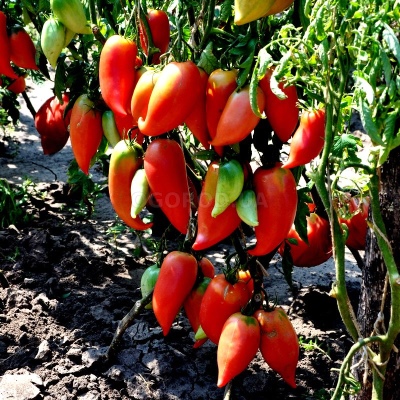
- Authors: Korea
- Category: grade
- Growth type: indeterminate
- Appointment: fresh consumption, for juice, for ketchup and tomato paste
- Ripening period: mid-season
- Ripening time, days: 110-120
- Growing conditions: for open ground, for greenhouses
- Bush size: tall
- Bush height, cm: 180-200
- Leaves: conventional type
Korean long-fruited is one of the versatile varieties of tomatoes. Its berries are distinguished by their neat and attractive appearance, excellent taste and variety in terms of their use in cooking. This variety is suitable for cultivation both in the open field and in an indoor greenhouse. The gardeners liked the Korean long-fruited so much that, having tried this variety once, they plant it in their greenhouses and gardens every year.
Breeding history
Country of origin - Korea.
Description of the variety
Reasons why you should give preference to the Korean long-fruited variety:
- high yield rate;
- high rate of seed germination (up to 90%);
- long fruiting period;
- wonderful taste of fruits;
- excellent presentation;
- varied uses in cooking;
- suitable for cultivation in greenhouses and in the open field;
- suitable for long-term transportation.
The disadvantages of the variety include:
- thermophilicity;
- the need for a bush garter, pinching and shaping.
The Korean long-fruited is a carp variety with an indeterminate growth type. The bush is tall: it can reach 180-200 cm in height. The stem has a liana-like shape. The leaves are thin, of the usual type, with a rich green color. The brush is simple, from 4 to 5 fruits can be tied on it.
The main qualities of the fruit
The fruits of this variety of tomatoes are elongated-cylindrical or elongated-heart-shaped with a curved nose. The color of the ripe fruit is crimson pink or crimson red. A ripe berry has an average size and weight of about 100–300 g. The flesh of the fruit is fleshy, sugary and juicy, it has a low seed content, the berry itself is dense and resistant to cracking.
Taste characteristics
The tomatoes of this variety taste sweet with a slight sourness. They can be used to make fresh salads, as well as juice, ketchup and tomato paste.
Ripening and fruiting
Korean long-fruited is a mid-season variety, ripening period is 110-120 days. Tomato bushes of this variety have a long fruiting period.
Yield
Korean long-fruited has a high yield: up to 8 kg of tomatoes per bush.
The timing of planting seedlings and planting in the ground
The developers of the variety recommend sowing seeds for seedlings in the first 10 days of March, and planting in the ground in the 2nd decade of May. When planted in early May, seedlings need shelter before the onset of stable warm weather.

Growing tomato seedlings is an extremely important process, because it largely depends on whether the gardener will be able to harvest at all. All aspects must be taken into account, from seedbed preparation to planting in the ground.
Landing scheme
Seedlings should be sown in small 10x10 cm containers with nutritious soil.After 55–65 days, when there are already 2 true leaves, the seedlings dive into a covered greenhouse or into open ground (when planting, a distance of 50 cm must be observed between the seedlings). A good planting soil will be the one in which root crops, legumes, greens and pumpkin crops were previously grown. The soil in which eggplants, potatoes, physalis and peppers grew are contraindicated.
The place for planting seedlings should be sunny and sheltered from the cold wind. The soil should be enriched with organic fertilizers containing calcium. Also, do not forget to water the plants every evening with warm water.

Growing and care
This variety has a high yield: about 10 clusters can form on one stem, each of which can contain from 4 to 7 large fruits. The best yield is obtained when a plant is formed with 2-3 stems. Since the bush grows quite tall, it must be tied to a vertical support.
Tomato tying is carried out throughout the summer season. When grown outdoors, pinch the tops of the stems 28–35 days before the onset of possible autumn frosts. If the air temperature is quite high, the greenhouse should be ventilated frequently in order to maintain the quality of the pollen of the plants.




A plant needs different micronutrients at each stage of growth. All fertilizers can be divided into two groups: mineral and organic. Folk remedies are often used: iodine, yeast, bird droppings, eggshells.
It is important to observe the rate and period of feeding. This also applies to folk remedies and organic fertilizers.
Disease and pest resistance
The Korean long-fruited variety is resistant to various pests, fungal diseases, as well as to peronospora and Alternaria. However, for prevention purposes, anti-late blight agents should be used. Also, the variety is prone to top rot.


Resistant to adverse weather conditions
This variety is very susceptible to different weather conditions. In particular, plants should be protected from drafts, strong winds and low temperatures.
Growing regions
Korean long-fruited can be grown in greenhouses, so gardeners in any region can cultivate this variety. When growing these tomatoes in an open area, farmers should consider its thermophilicity and vulnerability to weather conditions.
Review overview
Those who independently grew Korean long-fruited tomatoes leave a lot of positive reviews about it, noting the amazing taste and beautiful appearance of ripe fruits, their long shelf life after harvesting, as well as the possibility of growing both in a greenhouse and in the open field. Some gardeners, in addition to eating tomatoes of this variety, fresh or in the form of juice, roll them whole in jars.

























































































